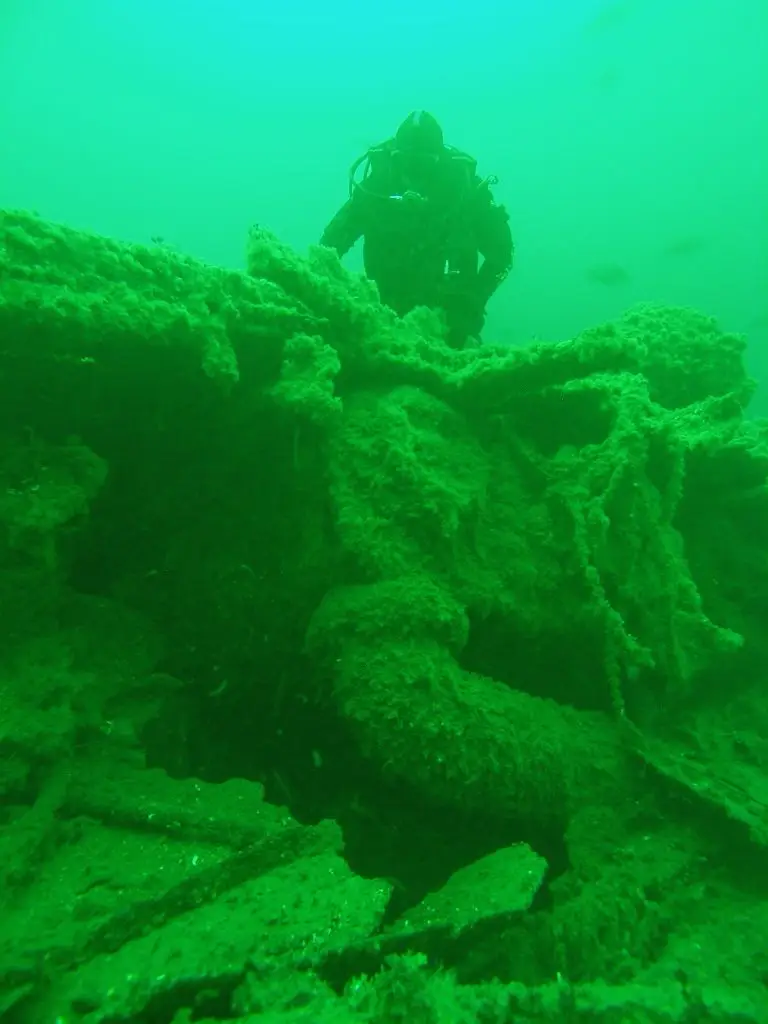The Princess Sophia: A Wreck to Remember

A dive on the tragic Princess Sophia had been on my bucket list for years, and friend Annette Smith in Juneau had regularly offered to put me on it. In 2018, the centenary year of its sinking, I boarded a plane to Juneau.
The next morning arrived early, with the alarm going off at 5:30 AM. We were at the boat by 7:00, and by 8:30, we were on site at Vanderbilt Reef. The weather gods were watching over us. The water was flat calm and there was no current despite some of the largest tidal exchanges of the year.
At 10:00 AM, my buddy Paul Spencer and I rolled into the water and started our descent. The first 40 feet of water was mucky with plankton, not unlike at home. At 50 feet, we got under it, and what a sight to behold. The bow of the Sophia was there in front of us, covered in brilliant white Plumose anemones, from top to bottom.
The Canadian Pacific BC Coast Service had the Princess Sophia built in England, especially for the Victoria, Vancouver to Skagway route. Built of steel, she was 245 feet long and called a “pocket liner” because she offered amenities like a great ocean liner, but on a smaller scale. Her licensed passenger capacity was 500 people.
The Victoria Daily Colonist described Princess Sophia upon her arrival at Victoria, BC, May 21, 1912.
Forward on the upper deck is a finely built and appointed observation room. The smoking room, set by itself in a deckhouse on the upper deck aft, is excellently and comfortably appointed. Forward is a spacious social hall, with a piano, and there are staterooms handsomely finished at either side. The dining room is aft on the main deck. It seats 112 people is finished in mahogany with maple panels.
Princess Sophia at Alert Bay BC. Unattributed Postcard
(J. Marc Collection)
Princess Sophia set sail from Skagway at 11:00 PM on October 23rd, 1918, with 344 passengers and crew.
After passing Battery Point, a short distance south of Haines, the steamer ran into a blinding snowstorm which continued down Lynn Canal until she ran on to Vanderbilt Reef at 3:10 AM on the 24th.
A May Day was issued immediately upon the grounding. The first rescue vessel the 85-foot SS Petersen arrived on scene at 09:00 AM. Captain Locke aboard the Sophia had the lifeboats swung out, but was fearful he would lose passengers if there was an attempt to launch the lifeboats in the rough seas. 
(J. Marc Collection)
Rescue plans were postponed until the morning of the 25th. On October 25th, the winds were worse, but the vessel was solidly on the reef so there wasn’t a lot of concern. By this time, the 200-foot rescue vessel SS Cedar was standing by and could communicate with the Sophia by wireless. Both captains agreed that there was little hope of rescue until the winds abated.
The SS Cedar retired to the lee of Sentinel Island approximately 5 miles (8 kilometers) away. At 4:50 PM, the Cedar receives a distress call from Sophia. “Taking on water and foundering, for God’s sake come and save us.” At 5:20, the telegraph operator sends one final message: “For God’s sake hurry water coming in room.” The strong northwest winds and large waves spun the Sophia around on the reef, tearing a hole in her double bottom and she sank with the loss of all passengers and crew.
After exploring the bow, Paul and I make a beeline for the stern. It lies in 130 feet of water and is the deepest part of the wreck. There we saw the rudder and one fluke of the propeller. The rest was buried in the sediment. After viewing the prop, we climbed back up to deck level and explored the amidships as we made our way back to the bow.
In all, we had six fabulous dives on the Sophia. She lies well heeled over on her port side, with much of her contents spilling out and raveling down slope producing an unrecognizable jumble of ship bits. She is intact along the keel but the hull has deteriorated and fallen in at the boiler room and again at the forward hold. Amongst the jumble amidships we could see toilets, sinks, bathtubs and well as deck winches. The mast which was the only visible vestige of the ship after she sank, lies in situ just down slope from the bow.


Paul Spencer is above compound steam engine; main steam pipe is still attached.
J. Marc Photo.
We learned a few key things about the wreck. Despite what is written, the boilers never exploded. That is a myth. All three boilers are intact. In addition, the main steam pipe is still connected to the compound steam engine. Another observation is that both anchors are still in their hawse pipes. Perhaps if they had been deployed, the ship would not have slid off the reef.
Sketch of wreck as she lies on the bottom at Vanderbilt reef. (c) J. Marc
Princess Sophia has never been surveyed, and most sport divers don’t always know what they are looking at. Because I like to be able to put context to a site, I took a stab at drawing what I saw.
It is a start, but she really needs to be documented in a more serious manner.
Sophia is a must-see wreck. I hope one day to pay her a return visit.
Watch Jacques’ presentation: Life Aboard Princess Sophia.









